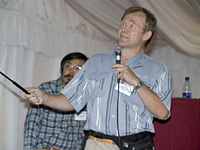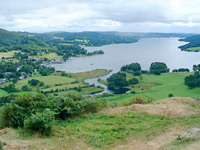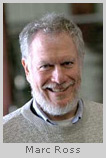 |
|
|
 |
ALCPG and GDE Host Town Hall Meeting at VLCW06
Submit Your Question Today

Valery Telnov of BINP Novosibirsk and Tsunehiko Omori of KEK (in the background) during the town hall meeting held at Snowmass in August 2005. |
Do you have a question about the Reference Design Report for the ILC? Or are you wondering about an ILC detector concept? Do you worry about how machine and detectors will work together? Or perhaps you have a question about the proposed timeline for building the ILC? At the Vancouver Linear Collider Workshop 2006, you will have the opportunity to ask your questions about the ILC on Thursday, July 20 at 7:30 p.m. in the Student Union Building Ballroom. (Dinner will be available on campus before the meeting starts.)
Organised by the American Linear Collider Physics Group and the Global Design Effort, the purpose of this town hall meeting is to establish stronger communication between the accelerator and detector communities for the ILC. A panel comprised of GDE and ALCPG members will answer questions and moderate the discussion. Topics for possible questions could include:
| • |
Programme planning and global coordination |
|
| • |
One vs. Two Detectors |
|
| • |
Upgrades and options for the machine and detectors |
|
| • |
Reference Design Report progress |
|
| • |
Detector Concept Report progress |
|
| • |
Timeline for building the ILC |
|
| • |
GDE/ALCPG Communications |
|
| • |
Machine and detector community relations |
If you have a question for the panel, please submit it in advance to communicators@linearcollider.org by Wednesday, July 12. Attendees will also have the opportunity to ask additional questions during the meeting.
All submitted questions will be posted on the VLCW06 web site prior to the town hall meeting. A programme will be organised around the submitted questions for the first part of the meeting, and the second portion will be dedicated to open discussion. If you submit a question ahead of time, please plan to attend the town hall meeting to pose it directly to the panel. The ALCPG and GDE encourage all workshop participants to attend the town hall meeting and look forward to the evening’s discussions.
-- Elizabeth Clements
|
 |
|
|
 |
Upcoming meetings, conferences, workshops
EPAC '06
Edinburgh, UK
26-30 June 2006
Vancouver Linear Collider Workshop
Vancouver, Canada
19-22 July 2006
ILC GDE Meeting
Vancouver, Canada
19-22 July 2006
2006 Linear Accelerator Conference
Knoxville, Tennessee, USA
21-25 August 2006
Linear Collider Physics School 2006
Ambleside, UK
14-19 September 2006
TTC Meeting (Tesla Technology Collaboration)
KEK
25-28 September 2006
9th International Workshop on Accelerator Alignment
Stanford Linear Accelerator Center
25-29 September 2006
Single Crystal Niobium Technology Workshop (pdf)
Araxá mine in Brazil
30 October - 1 November 2006
Request Information (email)
ILC GDE Meeting
Valencia, Spain
6-10 November 2006
Annual WILGA Conference
Warsaw University of Technology Resort, Poland
21-27 May 2007 GDE Meetings Calendar
|
|
 |
 |
|
|
 |
Cavity Buffs

A FLASH cavity during electropolishing |
Electrons are thrill-seeking particles. They get their kicks out of the superconducting cavities of the ILC. The higher their quality, the better the kick – so a team of scientists, engineers and technicians at DESY in Hamburg, Germany, makes sure that the cavities are buffed to the highest degree. A technique called electropolishing is currently emerging as the method to produce superclean superconducting radiofrequency cavities.
The cavities transfer energy to the particles. The field strength is in the order of tens of Megavolts. To reach this high voltage, the resistance within the cavity has to be as low as possible. The cavities are made of pure niobium, which becomes superconducting at very low temperatures. But every tiny speck of dust or dirt poses a threat to its superconductivity: the charge flowing through the material knocks electrons out of the inclusions or bits of dust, causing field emission; the area eventually warms up and the surface resistance rises. Finally, the cavity's surface becomes normal conducting: a thermal breakdown – a quench – occurs.
Read more...
-- Barbara Warmbein |
 |
|
|
 |
University of Lancaster Organises Linear Collider Physics School 2006

The town of Ambleside and Lake Windermere, viewed during the excursion at the 2003 school. |
Following the success of the first Linear Collider Physics School (2003) in Ambleside, which is located in the heart of the English lake district, the University of Lancaster will host the second Linear Collider Physics School also in Ambleside on 14-19 September 2006. With programme topics ranging from Higgs and supersymmetry to accelerators and the relation of Large Hadron Collider physics, the school is aimed at graduate students and postdocs who are working on the International Linear Collider.
Read more... -- Elizabeth Clements |
 |
|
|
 |
 From Fermilab Today and
From Fermilab Today and
SLAC today
29 June 2006
Marc Ross Named Head of Fermilab's Technical Division
SLAC physicist Marc Ross has been named head of Fermilab's Technical Division, beginning in the fall of 2006. Ross has played an integral part in SLAC's accelerator activities for many years...
Read more... |
|
From CRIENGLISH.com
27 June 2006
Chinese, US High-energy Physicists to Further Cooperate
Under the auspices of CAS and the US Department of Energy (DOE), a Workshop on Future PRC-US Cooperation in High Energy Physics was held from June 11 to 16 at the CAS Institute of High Energy Physics (IHEP) in Beijing...
Read more... |
|
From Kyoto Shimbun
15 June 2006
Host A Big Accelerator in Japan LDP started a federation to promote construction
On June 15, several LDP members met at the "Federation of
Diet members to promote the realization of ILC". Kaoru
Yosano, the Minister in charge of economic and fiscal
policy, and financial affairs, is the chair. The federation
will give advices to the Japanese government to join the ILC,
and to host it in Japan. (Kyoto News)
Read more in Japanese... |
|
From SLAC today
22 June 2006
ATF2: A Model for Future ILC Collaboration
Last month, just as crews were busy dismantling the decade-old Final Focus Test Beam (FFTB), a group of International Linear Collider (ILC) experts from Asia, Europe and America gathered at SLAC's sister lab in Japan to plan a new facility to take its place...
Read more... |
|
|
 |
 |
|
|
 |
Sokendai Linear Collider Accelerator School

Weiren Chou reporting to the GDE Executive Committee
following completion of the Sokendai Accelerator School. |
Not long after I became GDE Director, and even before I had recruited our initial design team, I gave a plenary talk on my ideas and plans for the ILC design effort at the Particle Accelerator Conference (PAC05) in Oak Ridge, Tennessee. While attending that conference, I was invited to a meeting of the ICFA Beam Dynamics Panel, chaired by Fermilab's Weiren Chou. We discussed the possibility of the GDE and the Beam Dynamics Panel co-sponsoring a linear collider accelerator school, and we would provide the lecturers. One year later, on 19-27 May 2006, we successfully held such an accelerator school in Sokendai, Hayama, Japan. (see NewsLine 1 June 2006).
The path to becoming an accelerator physicist is not straight-forward. Accelerator schools not only provide enrichment for young accelerator physicists, they also play a central role in teaching future generations. Most universities do not have any accelerator physicists on their faculties, and therefore do not offer courses or PhD theses in the field. Most accelerator physicists have converted from other areas of experimental physics through learning at schools like Sokendai, and by on the job training at accelerator laboratories. Therefore, we felt obliged to sponsor the Sokendai School to help enhance the pipeline for young potential accelerator physicists.
Read more...
--Barry Barish
Director's Corner Archive |
 |
|
|
 |
|

